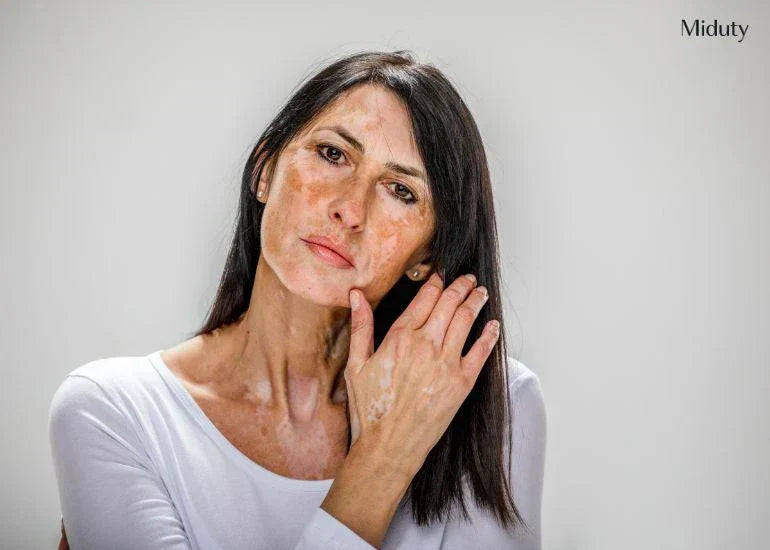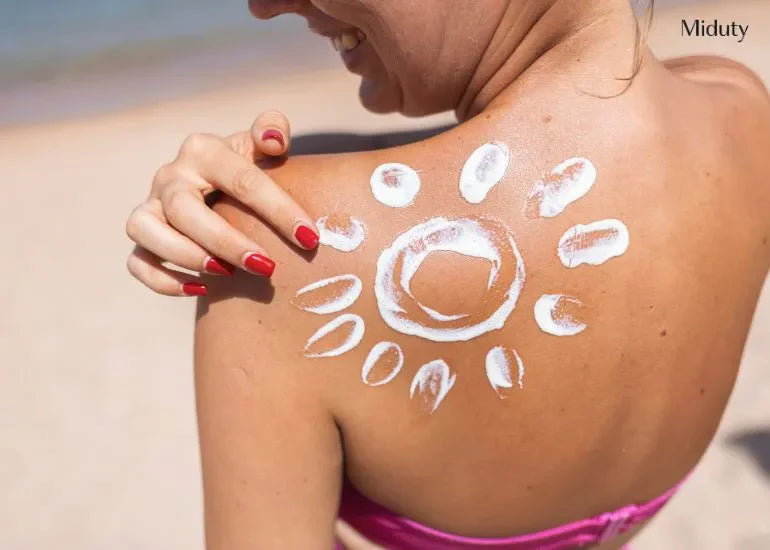
6 Steps Night Skin Care Routine For Healthier & Glowing Skin
You've probably heard the phrase "beauty sleep" — but have you ever wondered why it exists?
During the day, your skin is busy defending itself from pollution, sun exposure, sweat, and stress. But at night, it finally gets a break from all these environmental stressors. And it's not just resting—it's, in fact, working overtime to repair, regenerate, and restore.
According to a study published in the National Library of Medicine, skin cell regeneration doubles at night, peaking between 11 PM and 4 AM. This is when your skin absorbs active ingredients best and heals faster.
Yet most people either skip a proper night routine or rely on inconsistent habits. And that's where the skin damage starts—breakouts, pigmentation, dullness, and premature aging.
A well-crafted night skin care routine isn't about a 10-step process. It's about targeted care at the right time, with the right ingredients.
Let's understand how you can give your skin this targeted care and build an effective, soothing, and science-backed night skin care routine.
Key Takeaways
1. Skin's cell turnover is highest between 11 PM and 4 AM, making nighttime the prime repair window.
2. Skin loses up to 25% more water at night — hydration is critical after sundown.
3. Skin temperature rises while you sleep, allowing for deeper absorption of active ingredients.
4. A consistent night skin care routine has been shown to improve skin tone and elasticity by 30% in 6 weeks.
Why You Need a Night Skin Care Routine?
Let's face it: after a long day, the last thing you want is a 15-minute routine in the bathroom.
But your skin doesn't clock out—and neglecting it at night can cause more harm than skipping a morning cleanse.
During sleep, your skin:
1. Repairs microtears and inflammation
2. Reverses oxidative damage from UV and pollution
3. Restores hydration and collagen production
Without cleansing, you're leaving behind SPF, sweat, and grime that clog pores overnight. Without moisturizing, you're letting water loss age your skin prematurely.
The good news? You only need a few intentional steps to support your skin overnight.
Let's build a night skin care routine that's clean, effective, and sustainable — not based on trends, just results.
Night Skin Care Routine Steps (Beginner to Advanced)
Whether you're a skincare minimalist or someone ready to go the extra mile, this breakdown will help you personalize your nighttime flow:
Step 1: Remove Dirt, SPF, & Grime with a Gentle Cleanser
Even if you stayed indoors, your skin builds up oil, sweat, and environmental toxins.
- Use a gentle, pH-balanced cleanser that won't strip your skin barrier. If you have sensitive skin, avoid using AHAs and BHAs as they can be harsh to your skin and may also damage your skin barrier in the long term.
Instead, use gentler alternatives to such exfoliating agents, like flower-based exfoliating acids. Such ingredients give you the same exfoliating effect while being gentle on the skin.
- If you wear sunscreen or makeup, double cleansing is ideal—start with an oil/balm cleanser, and then follow up with a gentle face wash.
Pro Tip: Cleansing before bed increases product penetration by up to 60%.
Step 2: Apply a Hydrating Toner or Mist (Optional but Helpful)
More than just a pampering step, toners help rebalance your skin's pH and prepare it to absorb your night skin care routine products more efficiently.
- Choose alcohol-free toners with natural ingredients like cucumber, rose water, or rice extract.
Spritzing a hydrating mist post-cleansing your face can also calm any irritation and add an instant hydration boost, especially in dry climates or AC environments.
Step 3: Use a Targeted Serum
This step is where the magic starts happening. At night, your skin is most receptive to repairing actives. So if you're addressing concerns like pigmentation, dullness, acne, or fine lines, serum becomes one of the essential night skin care routine steps.
Ingredients like Hydroquinone and Kojic Acid are so much in vogue nowadays for that brightening effect, but the truth is they are apparently not safe to be used regularly. As per the National Library of Medicine, Hydroquinone, because of its unknown safety profile, is banned in the EU, Japan, and Australia.
So now what to use for skin brightening and pigmentation?
- For Hyperpigmentation & Anti-Aging: Use Niacinamide in a concentration of minimum 5%. It will help reduce the signs of aging and work on skin lightening just as effectively as Hydroquinone, that too, without any side effects or long-term harm to the skin.
- For Skin Lightening: RAYOLYS is an ingredient that indeed works better than the hyped ingredients in the market, like Kojic Acid and Hydroquinone. This is a natural, botanical blend, a gentler alternative to the conventional skin brightening ingredients.
- For Hydration: Hyaluronic Acid, Squalane, and aquaporin are the ingredients that enhance the skin's hydration naturally. While choosing Hyaluronic Acid, always go for low molecular weight Hyaluronic Acid; it helps in better ingredient penetration deep into the skin layers and keeps the skin hydrated and plump for longer.
Step 4: Lock It In with a Night Moisturizer or Cream
Now that you have given your skin a targeted treatment for the skin concerns, it's time to give your
Skin loses more moisture at night, so sealing in hydration is a non-negotiable in your night skin care routine. After applying serum, lock in the product in your skin using a night moisturizer or a skin barrier repair cream.
- Creams > gels at night as they're richer and last longer
- Look for ingredients like ceramides, peptides, oat beta-glucan, or squalane etc. Such ingredients help in retaining the moisture in your skin overnight while keeping the skin barrier intact.
Studies show that applying a ceramide-rich moisturizer at night can improve barrier function by over 50% in two weeks
Don't forget: If your skin feels tight or dry by morning, your moisturizer isn't doing enough.
Step 5: Use an Eye Cream (If Needed)
The under-eye area is thinner and shows signs of fatigue first.
- Choose eye creams with caffeine (for puffiness), niacinamide (for dark circles), or peptides (for fine lines)
- Tap gently with your ring finger—don't rub a lot.
Step 6: Lip Care + Extras
You've cleansed, hydrated, and nourished your skin, but if you skip your lips, you're leaving the most delicate part of your face unprotected. Dry, cracked lips can undo all that night skin care routine glow and make your face look tired.
- Use lip balms with shea butter, lanolin, or beeswax
- For dark lips, look for ones with licorice extract or vitamin E
Optional: You can add overnight sleeping lip masks 1–2x a week if your skin is exposed to pollution or stress.
Conclusion
Your skin isn't resting while you sleep—it's working overtime.
A smart, minimal night skin care routine supports your skin's natural overnight renewal, improves elasticity, fades imperfections, and boosts hydration—all while you sleep.
You don't need 10 complex night skin care routine steps regimen. Just following the right night skin care routine for your skin type can transform your skin texture and tone in just a few weeks.
Whether you're starting with 3 steps or building toward a full routine, the key is consistency, not perfection.
Start tonight. Wake up with better skin tomorrow.
Frequently Asked Questions on Night Skin Care Routine
Q1. What should be my night skin care routine?
Your night skin care routine should include cleansing to remove dirt and pollutants, followed by a hydrating moisturizer or a barrier repair night cream. You can also add targeted steps like serums or eye creams based on your skin concerns.
To sum up, the most essential night skin care routine steps are: cleanse, treat (optional), moisturize, and protect (lips or barrier).
Q2. What can I apply on face at night?
At night, apply products that help restore and repair your skin. This includes a gentle cleanser, a hydrating or brightening serum, and a night moisturizer or barrier repair cream. If you follow a structured night skin care routine steps, you can also add eye cream and lip balm for full-face care.
Q3. Can I use Vitamin C serum at night?
Yes, but it depends on your skin type and sensitivity. It can be used at night as part of your night skin care routine for brightening and antioxidant protection. However, avoid layering it with strong acids or retinol.
Q4. How to glow skin in one night?
Quick glow-ups are possible with the right night skin care routine steps. Double cleanse, use a hydrating or brightening mask, apply a nourishing serum, and seal with a night cream. Drink water, sleep well, and avoid sugar before bed — your skin reflects all of it.
Q5. Which serum is best at night?
For your night skin care routine, choose a serum based on your skin concern. Niacinamide (5% or higher) is great for pigmentation and signs of aging, offering results similar to Hydroquinone but without side effects. For natural skin lightening, RAYOLYS is a safer alternative to Kojic Acid. And for hydration, go for low molecular weight Hyaluronic Acid or Squalane to deeply nourish and plump the skin overnight.
Q6. Can I apply moisturizer at night?
Absolutely. Moisturizer is one of the most important night skin care routine steps. At night, your skin loses more moisture, so applying a good moisturizer helps repair the skin barrier, lock in hydration, and support overnight renewal.
References












